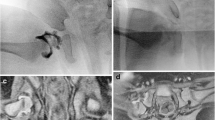Abstract
Purpose
Closed reduction and spica cast immobilization are routinely used for young patients with developmental dysplasia of the hip with reducible hips. Our primary objective was to assess the interpretation quality of immediate post-operative pelvis radiographs after treatment.
Methods
A series of 28 randomly selected patients (30 hips) with pre- and post-operative pelvis radiographs and post-operative magnetic resonance imaging were included. Each was presented twice with an interval of two weeks, in alternating orders. Raters with different experience and specialties from different institutions rated the quality of reduction (hip in or out) after treatment.
Results
Thirteen surgeons and three radiologists evaluated 30 hips (28 patients). Agreement was not satisfactory (κ = 0.12). Experienced clinicians demonstrated similar agreement to inexperienced raters (κ = 0.04). Consistency at a two week interval was moderate (κ = 0.48, percent of agreement at 82%). The mean number of errors from the two ratings were 8.6 ± 2.5 and 8.9 ± 2.7, respectively (P = 0.72). There was no significant difference between surgeons with different levels of experience; radiologists did better than surgeons, but the difference was insignificant. Raters from different institutions had similar performance in poor judgment.
Conclusions
Our results show poor concordance between observers and ratings. Post-operative radiographs are unreliable for assessing the quality of hip reduction. The level of experience, subspecialty, and geographical origin do not impact the radiographic assessment. Based on the present findings, we recommend performing post-operative magnetic resonance imaging rather than anteroposterior pelvis radiograph to assess the hip. Compared to standard radiographs, magnetic resonance imaging allows more reliable interpretation while decreasing radiation exposure.



Similar content being viewed by others
References
Malvitz TA, Weinstein SL (1994) Closed reduction for congenital dysplasia of the hip. Functional and radiographic results after an average of thirty years. J Bone Joint Surg Am 76(12):1777–1792
Desai AA, Martus JE, Schoenecker J, Kan JH (2011) Spica MRI after closed reduction for developmental dysplasia of the hip. Pediatr Radiol 41(4):525–529. https://doi.org/10.1007/s00247-010-1965-3
Dibello D, Odoni L, Pederiva F, Di Carlo V (2017) MRI in postreduction evaluation of developmental dysplasia of the hip: our experience. J Pediatr Orthop https://doi.org/10.1097/BPO.0000000000001037.
Ge Y, Cai H, Wang Z (2016) Quality of reduction and prognosis of developmental dysplasia of the hip: a retrospective study. Hip Int 26(4):355–359. https://doi.org/10.5301/hipint.5000348
Starr V, Ha BY (2014) Imaging update on developmental dysplasia of the hip with the role of MRI. AJR Am J Roentgenol 203(6):1324–1335. https://doi.org/10.2214/AJR.13.12449
Jaremko JL, Wang CC, Dulai S (2014) Reliability of indices measured on infant hip MRI at time of spica cast application for dysplasia. Hip Int 24(4):405–416. https://doi.org/10.5301/hipint.5000143
Gans I, Sankar WN (2014) The medial dye pool revisited: correlation between arthrography and MRI in closed reductions for DDH. J Pediatr Orthop 34(8):787–790. https://doi.org/10.1097/BPO.0000000000000187
Aoki K, Mitani S, Asaumi K, Akazawa H, Inoue H (1999) Utility of MRI in detecting obstacles to reduction in developmental dysplasia of the hip: comparison with two-directional arthrography and correlation with intraoperative findings. J Orthop Sci 4(4):255–263
Verma K, Sitoula P, Gabos P, Loveland K, Sanders J, Verma S, Shah SA (2014) Simplified skeletal maturity scoring system: learning curve and methods to improve reliability. Spine (Phila Pa 1976) 39(26):E1592–E1598. https://doi.org/10.1097/BRS.0000000000000653.
Zuckerman SL, Lakomkin N, Magarik JA, Vargas J, Stephens M, Akinpelu B, Spiotta AM, Ahmed A et al (2017) Evaluation of previously embolized intracranial aneurysms: inter- and intra-rater reliability among neurosurgeons and interventional neuroradiologists. J Neurointerv Surg. https://doi.org/10.1136/neurintsurg-2017-013231
Reem J, Carney J, Stanley M, Cassidy J (2009) Risser sign inter-rater and intra-rater agreement: is the Risser sign reliable? Skelet Radiol 38(4):371–375. https://doi.org/10.1007/s00256-008-0603-8
Fleiss JL, Cohen J (1973) The equivalence of weighted kappa and intraclass correlation coefficient as measures of reliability. Educ Psycol Meas 33:613–619
Landis JR, Koch GG (1977) The measurement of observer agreement for categorical data. Biometrics 33(1):159–174
Li Y, Guo Y, Li M, Zhou Q, Liu Y, Chen W, Li J, Canavese F, Xu H et al (2017) Acetabular index is the best predictor of late residual acetabular dysplasia after closed reduction in developmental dysplasia of the hip. Int Orthop. https://doi.org/10.1007/s00264-017-3726-5
Herring JA (1982) Inadequate reduction of congenital dislocation of the hip. J Bone Joint Surg Am 64(1):153
Race C, Herring JA (1983) Congenital dislocation of the hip: an evaluation of closed reduction. J Pediatr Orthop 3(2):166–172
Dimeglio A, Canavese F (2011) Imaging in Legg-Calvé-Perthes disease. Orthop Clin N Am 42(3):297–302. https://doi.org/10.1016/j.ocl.2011.04.003
Clohisy JC, Carlisle JC, Trousdale R, Kim YJ, Beaule PE, Morgan P, Steger-May K, Schoenecker PL, Millis M (2009) Radiographic evaluation of the hip has limited reliability. Clin Orthop Relat Res 467(3):666–675. https://doi.org/10.1007/s11999-008-0626-4
Forlin E, Choi IH, Guille JT, Bowen JR, Glutting J (1992) Prognostic factors in congenital dislocation of the hip treated with closed reduction. The importance of arthrographic evaluation. J Bone Joint Surg Am 74(8):1140–1152
Bitar KM, Ferdhany ME, Ashraf EI, Saw A (2016) Physical and clinical evaluation of hip spica cast applied with three-slab technique using fibreglass material. Malays Orthop J 10(3):17–20. https://doi.org/10.5704/MOJ.1611.008
Author information
Authors and Affiliations
Corresponding author
Ethics declarations
Conflict of interest
The authors declare that they have no conflict of interest.
Ethical approval
All procedures performed in studies involving human participants were in accordance with the ethical standards of the institutional and/or national research committee and with the 1964 Helsinki Declaration and its later amendments or comparable ethical standards.
Informed consent
No patients were involved. This is a retrospective study of patient’s data, and an IRB approval was obtained (2017102307).
Rights and permissions
About this article
Cite this article
Yong, B., Li, Y., Li, J. et al. Post-operative radiograph assessment of children undergoing closed reduction and spica cast immobilization for developmental dysplasia of the hip: does experience matter?. International Orthopaedics (SICOT) 42, 2725–2731 (2018). https://doi.org/10.1007/s00264-018-4038-0
Received:
Accepted:
Published:
Issue Date:
DOI: https://doi.org/10.1007/s00264-018-4038-0




